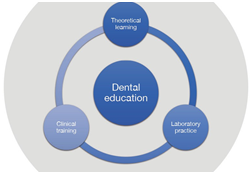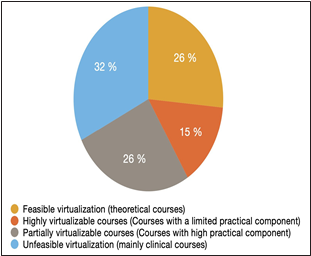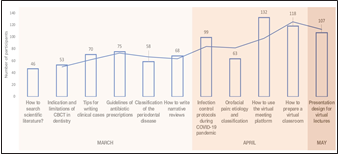Introduction
When you ask dentists, anywhere in the world, about their memories from Dental School (DS) training, you will end up with a pool of stories about different experiences: the doctor in front of a classroom, the strong smells from laboratory, practice drilling on extracted teeth, mixing acrylics, and the anxiety before administering their first anesthetic injection in a patient. The last experience is the most relatable, since starting clinical practice is considered as the most stressful year because of the fear and apprehension about patient contact (1). Unlike many other careers, dentistry is an amalgamation of three fundamental components: theory, laboratory, and clinical practice; under this triage, a vast number of social programs, research projects, and interdisciplinary learning experiences are intricated (Figure 1). These interactions mostly take place in DS where teachers, students, and patients share more than just the school’s infrastructure. Now, try to imagine an uncommon scenario where this learning process has been interrupted because of a natural catastrophe, political crisis, or the threat of an unknown virus.
For many careers, the migration from a face- to-face setting to a virtual/remote communication started as soon as the worldwide web and the emerging collateral technologies were accessible (2,3). The number of available online academic programs, especially postgraduate programs, is on the rise in different modalities (4). Many disciplines understood that replacing the old classroom for a virtual scenario was not betraying the “classic pedagogic pathway,” but an opportunity to innovate, facilitate learning, improve access to education, and optimize the available resources. Unfortunately, the traditional triage in dental education limits the implementation of e-learning strategies. In the last decade, technologies such as virtual reality simulators, augmented reality, and computer aided design/computer aided manufacturing (CAD/CAM) systems have facilitated the introduction of these strategies in some DSs, especially for clinical and pre-clinical disciplines (5,6,7).
A recent publication in the Journal of Dental Research discussed some challenges that dentists and dental education will face due to the COVID-19 pandemic (8). The authors analyzed the educative process developed during the COVID-19 outbreak in the Stomatology School at the University of Wuhan, China, emphasizing on the measures taken to ensure the protection of the students’ health by reinforcing infection control protocols in the clinical setting. They also recommend using e-learning activities like online lectures, virtual case studies, and problem-based learning tutorials as measures to avoid unnecessary crowding exposure.
Understanding the positive impact and some challenges of virtualizing the dental education makes us consider the present and future of e-learning in DS in developing countries. Are these regions prepared to digitalize and to integrate e-learning experiences into their curricula? Do they have to deal with the same challenges richer countries have dealt with? Is it possible to use the experiences generated by the pioneer countries/institutions to enhance these processes in the poorer countries? This article aims to explore some of these issues and to offer potential answers with the available information. We hope that the discussion generated here will help DS worldwide into a new urgent educational realm, forced by this viral pandemic.
E-Learning In Dentistry: A Panoramic View
With the social dissemination of information and communication technologies (ICT), the growth of Internet users, and the fast evolution of a wide variety of mobile electronic devices (e.g., smartphones, tablets, and laptop computers), the concept of e-learning has gained substantial recognition in dentistry, even though it has been around since the early 1990s (9). It has been discussed that the traditional e-learning platforms, despite their large diffusion and consolidation, need to widen the range of possibilities required by the users, and be comprised of a complex electronic ecosystem focused on the teaching/learning symbiosis and knowledge management, both, at an institutional and a personal level (10).
E-learning includes a variety of modalities and terms such as online learning, mobile learning, blended learning, computer assisted instruction, distance learning, e-teaching, mediated learning, simulation-based learning, and virtual learning, each one of these having their own operative differences but all part of the digital learning ecosystem (11). However, independent of the modalities, e-learning is built on three key elements: the various pedagogical models, the instructional and learning strategies, and the pedagogical tools or online learning technologies (12).
According to a recent systematic review (13), some barriers or challenges reported for implementing e-learning strategies in health sciences education are (i) poor motivation and/or expectation: from the learners caused by internal factors (e.g., poor engagement, high levels of anxiety and stress, lack of student’s self-discipline) and external factors (course structure, poor pedagogical design, management policy, limited use of technology in education, lack of support); (ii) resource-intensive: time-, cost- and labor- intensive approach of e-learning programs; (iii) no suitability for all disciplines/contents: for contents with the need for practical or demonstrative activities, where e-learning is hard or nearly impossible to implement; (iv) lack of IT skills: especially untrained persons in computer skills. Dental education faces all the listed challenges for the complexity and variety of courses that are required. However, the biggest unresolved challenge is to analyze and commonly agree on the ideal evaluation tools necessary for each discipline and teaching method. A thorough cultural transformation in the education system, following standardization, validation, and equivalence testing, is necessary to ensure an appropriate blended curriculum of traditional face- to-face teaching and e-learning (14).
Literature points out some enablers for implementing e-learning strategies in DS courses, such as (i) facilitate learning: a more integrated and contextualized learning may develop an optimal interaction between students and teachers; (ii) learning in practice: an effective approach for transferring clinical skills and knowledge using virtual clinical case studies, adopting a mixed learning approach, and combining distinct styles and modalities; (iii) systematic approach to learning: moving from simple to complex concepts, logically interconnecting knowledge and ideas for more consolidated learning; and (iv) integration of e-learning into curricula: combining face-to- face classroom experiences with online learning to stimulate independent, interactive, and collaborative learning with a flexible and technologically rich format (13).
DSs have successfully integrated e-learning into curricula for some specific contents, as the use of virtual teaching in dental education is gaining acceptance as a complementary method to traditional learning. Integrating virtual patients (VP), a computer simulation of real-life clinical scenarios (15), as part of a student’s clinical training is one example on how dental education could benefit from e-learning strategies. VPs have been used to develop patient interviewing skills, analysis of ethical cases, and clinical decision making in many specialties. VPs offer advantages such as efficiency, interactivity, a broader range of exposure to rare but critical cases, and more significantly, the student improves his/her clinical skills in a non-threatening setting. In a 2012 survey of the U.S. and Canadian DSs, 63% of the respondents confirmed the usage of VPs for preclinical or clinical exercises (16). The authors of this 8-year old survey had concluded that the use of VP in dental education was on the rise, and thus we can infer that more DSs have integrated this virtual tool in their courses. The study noted some advantages like, the reinforcement of basic sciences during clinical treatment considerations, the uniformity of student experiences, and the immediate feedback and self-assessment.
Virtual reality (VR) technology has been defined as a method by which a three-dimensional environment is simulated, giving the user a sense of being inside this environment, controlling, and interacting with it (17). It has been used for patient education, medical students’ training, instruction of surgical procedures (18), and recently in dental training (19,20). Augmented reality (AR) is a superimposition of computer-generated graphics over a real-life scene, and unlike VR, the actual situation is not entirely suppressed (21). In dentistry, it has been used in the training for dental implants, maxillofacial surgery, temporomandibular joint motion analysis, and prosthetic surgery, permitting the student/dentist to envision deep masked structures, allowing for a 3D planning of the surgical procedure, and even designing virtual surgical guides (19,22). The applications of CAD/ CAM technologies in dental laboratories and as dental chairside tools have been rapidly increasing over the last decade. The CAD/CAM process comprises of a digitization tool, a data processing software, and a manufacturing technology (either subtractive like milling or additive like 3D printing). The use of CAD/ CAM can be inculcated in teaching prosthodontics, maxillofacial surgery, orthodontics, periodontics, endodontics, and restorative dentistry (6).
A qualitative study employing focus groups for data collection evaluated the learning experience of dental students who used Internet Visual Resources (IVRs), defined as, visual materials (videos, animations, photos) that were freely available on public websites. They found that the most commonly used IVRs were videos of clinical demonstrations performed on real-life patients. This tool was especially helpful for the beginners. This form of visual aid was more attractive to students than reading the procedure from a textbook (23). A recent survey confirmed these findings on 3rd, 4th, and 5th year dental students at the University of Montpellier where researchers aimed to identify the pedagogical support the students preferred according to their discipline. They concluded all students requested videos for clinical subjects like endodontics, and 95.7% of students reported online classes and e-learning as useful (1). Dental students reported, in another survey, to accept e-learning during their clinical training, which was most likely due to the favorable accessibility to the hardware and Internet. Although, it is important to highlight that they obtained these results from a sample of dental students in their second and third clinical semester at the University of Mainz, Germany; and all the participants had access to at least one hardware type suitable for e-learning (24).
By analyzing the currently available pedagogical tools and the role of mobile technology (especially via smartphones) with its rapidly changing approach to learning and teaching in clinical dental education, a warning flag must be raised. Several IVRs of clinical procedures are abundantly available on varied Internet portals. Globally, dental students widely use these mobile tools to access information. However, how little do we know about their ability to discern and recognize between evidence-based information and unsupported materials? Academic institutions should be aware of this imminent challenge and prepare the teachers and clinical instructors to provide proper guidance to their students about using mobile technology and searching for online information (25).
Continuing dental education programs have benefited from webinars, online courses, and web- based learning tools as an attractive and lucrative option because of the capacity to deliver constant training, increased learner convenience, flexibility of the process, personalized learning options with lower costs, and the ease of delivery (26).
E-Learning Versatility: Opportunities For The Students And Faculty
As discussed previously, several reports support the use of virtual educative aids in dentistry. Although the academic institutions can implement few modalities easily, most of them require trained personnel and a sound budget to support the necessary infrastructure and equipment. Using these academic tools may vary among the disciplines, as well as their acceptance by the students and teachers. Tables 1, Table 2, and Table 3 briefly summarize a literature review on the application of e-learning modalities in dentistry (Tables 1, Table 2, and Table 3).
Table 1 Summary of the reports of e-learning in dentistry (orthodontics, cariology, pharmacology, and periodontics).
| - | Author/Year | Aim | Observations |
| Pathology/Histology | Fernandes C et.al. 2018 (27) | To analyze the perceptions and performance of dental students in oral pathology regarding conventional or virtual microscopy (VM) in relation to teaching and learning. | VM (technology for showing microscope slides using computers) showed positive student perceptions, and it represents an important tool in oral pathology training in dental education. This tool positively influenced students’ participation in the discipline. |
| - | Ariana A et.al. 2016 (28) | To assess the effectiveness of electronic learning tool vs traditional teaching methods in students’ performance, understanding, and satisfaction in a general pathology course. | The students who experienced online learning modules along with traditional teaching methods performed better in the general pathology course and found the course more helpful, due to the better accessibility, access to self evaluation, higher student engagement, and the ease of receiving support from the teaching staff in the online learning modules. |
| - | Alotaibi O et.al. 2016 (29) | To compare the VM vs light microscope (LM) to assess student perceptions concerning the influence of virtual microscopy on their learning | VM is a highly preferred substitute for LM for teaching oral histology and pathology to dental students, however the authors recognize that dental students must learn how to use LM. The authors believe that it is essential to briefly expose the students to conventional LM and glass slides during their education. |
| - | Brierley et.al. 2017 (30) | To describe how VM has been used to enhance dental students’ learning of oral pathology, and its role in facilitating an integrated oral disease. | Student feedback on their learning experience with VM has been overwhelmingly positive. This was reflected in their ability to view identical images simultaneously with their peers, tutors and the class leader, facilitating productive discussion. VM enhanced the ability to teach oral pathology to both our undergraduate and postgraduate students. |
| Oral Medicine | Roxo-Gonzalves et.al. 2017 (31) | To assess the diagnostic skills of professionals regarding oral mucosal lesions, comparing dentists/no dentists. | Distance learning courses may improve the knowledge required for better oral cancer detection, keeping in mind that low motivation and compliance are important obstacles that remain to be overcome. |
| - | Mardani M et.al. 2020 (32) | To investigate the Virtual patient (VP) based training on the students’ clinical decision-making ability on herpes simplex virus infections and recurrent aphthous stomatitis. | VP-based training is an active student centered learning strategy that improved learning in a safe and controlled environment; and enhances dental students’ ability to make clinical decisions. The level of learning was higher in the VP group compared to the classroom training, whereas the retention rate was higher in the in-person approach. |
| Maxilofacial | Weiner CK et.al. 2016 (33) | To evaluate the use of web-based simulation of patients (Web SP) in oral surgery education for dental students and to assess its impact on learning outcomes regarding clinical reasoning. | Web SP program on third year dental students showed a statistically significant increase in knowledge, and that the students had a positive attitude towards the teaching method. These results suggest that Web SP is a valuable tool for oral surgery education. |
| - | Seifert LB et.al. 2019 (34) | To evaluate the use of VP in the acquisition of theoretical knowledge and clinical reasoning skills in Oral/Maxillofacial Surgery vs. lecturer-led Small Group Teaching (SGT). | VP cases are an effective alternative to lecture led SGT in terms of learning efficacy in the short and long term as well as self assessed competence growth and student satisfaction. Integrating VP cases is feasible within a curricular Oral and Maxillofacial Surgery Clerkship and leads to substantial growth of clinical competence in undergraduate dental students. |
| Removable | Mahrous A et.al. 2019 (35) | To compare student outcomes as well their feedback on the use of virtual 3D as an alternative to 2D paper-based exercises in the preclinical removable prothesis design exercise. | Despite no significant difference in outcomes as reflected in exercise evaluation scores, the students showed an overwhelming interest in having the virtual 3D casts as part of the curriculum. |
| - | Lin WS et.al. 2018 (36) | To evaluate the students’ usage/perceptions of smartphones in dental education and learning tooth preparation with the virtual 3D instructional models. | 3D models provide supplemental instructional materials for teaching tooth preparation in the pre clinical removable partial denture course. Students showed overall positive perception towards smartphones usage in dental education and the individually designed virtual 3D instructional models. |
| Fixed prothesis | Botelho M 2019 (37) | To examine student access to the videos on 4th year cohorts using an evaluation feedback questionnaire from accessing the learning management system. | 100 online video clips were created to support students’ learning laboratory teaching sessions in a fixed prosthodontics course. All the students reported that the videos helped in their learning, preparation for simulation laboratory classes, to refresh their memory prior to clinical care, prepare for the clinical competency test and prepare for examinations. |
| - | Reissmann DR et.al. 2015 (38) | To create a blended learning model that presents learning goals in the context of the theoretical background in combination with learning checks and corresponding access restrictions. | The blended learning (demonstrative e learning modules) represents a promising add on to existing educational methods and was appreciated by the students. Even though blending learning had a positive impact on these students’ satisfaction with learning material and learning effect, future studies should also include objective measures of students’ performance. |
| - | Liu L et.al. 2019 (39) | To evaluate the effectiveness of a preclinical training of ceramic crown preparation using Virtual Educational System for Dentistry (VESD) with 2 more systems. | The VESD vs Virtual Learning Network Platform and Real time Dental Training and Evaluation System was suitable for the preclinical course of dental practice. The VESD could improve the dental students’ abilities in tooth preparation, particularly preparation section, preparation reduction, and preparation surface and profile (maybe due to its advantages such an objective assessment and feedback, and unlimited training time and space. |
Table 2 Summary of the reports of e-learning in dentistry (pathology, oral medicine, maxilofacial surgery, removable prosthesis, and fixed prothesis).
| - | Author/Year | Aim | Observations |
| Restorative Dentistry | Camargo LB 2014 (40) | To evaluate the potential of an e learning strategy in teaching Atraumatic Restorative Treatment (ART) in undergraduate and graduate dental students | The e learning strategy has the potential of improving students’ knowledge of ART. Mature students perform better with this teaching modality when applied exclusively via distance learning. |
| Orthodontics | Mehta S 2016 (41) | To assess student learning experiences among undergraduate dental students exposed to e learning resources covering a broad range of orthodontic topics. | The e learning modules have proved popular among undergraduate orthodontic students and were found to enhance the learning experience. Students found that the e resource was a useful supplement to lectures and interactive features such as immediate feedback to questions were particularly favorably. |
| - | Asiry MA 2017 (42) | To identify the readiness of students for online learning, and their preference/perception of online tutorials within the preclinical orthodontic course. | Overall positive responses were reported by the students regarding the acceptability and usability of online learning. The students viewed online learning helpful as a supplement to their learning rather than a replacement for traditional teaching methods. |
| - | Ludwig B et.al. 2016 (43) | To assess the additional effect of two e learning methods for teaching cephalometry in addition to the traditional training of undergraduate dental students | All students using this e learning method improved their results identifying anatomical landmarks correctly. This methodology might open a new avenue for teachers to develop their own teaching modules efficiently. Using more either a traditional teaching method or a sophisticated e learning software did not appear to be more effective than the simplified e learning method tested. |
| - | Lima MS et.al. 2019 (44) | To evaluate the effectiveness of distance learning strategies applied to the teaching of orthodontics | The growth of distance learning in universities is undeniable, but the effectiveness of this method requires further research. There are no studies evaluating student information retention over the long term. Distance learning in orthodontics is an effective but complementary element with no significant differences from the traditional teaching method. |
| Cariology | Alves LS et.al. 2018 (45) | To assess the performance of dental students for detecting in vitro occlusal carious lesions using the ICDAS with different learning strategies, including digital learning tool (DLT). | Both training strategies (ICDAS e learning alone and ICDAS e learning + DLT) improved the performance of dental students for the in vitro detection of occlusal carious lesions, mainly when the combination of methods was used. The combined ICDAS e-learning + DLT improved the relationship between sensitivity and specificity for the detection of carious lesions at all assessed thresholds. |
| - | El-Damanhoury H et.al. 2014 (46) | To determine if e learning could improve the diagnostic skills in identifying non cavitated occlusal carious lesions | Using ICDAS II e learning program in combination with conventional teaching of ICDAS II significantly improves diagnostic skills of the dental students, especially in detecting caries in its early stages. |
| - | Luz PB et.al. 2015 (47) | To evaluate the effect of an experimental digital learning tool on undergraduate dental students’ performance in detecting dental caries using ICDAS. | The use of the learning tool after the ICDAS e-learning program tended to increase the sensitivity of ICDAS when used by undergraduate dental students to examine a population of children in whom caries prevalence was low and could help students in the process of learning ICDAS scoring. |
| Pharmacology | Rosenbaum PE et.al. 2012 (48) | To evaluate the effect of 15 hours of lectures and online learning activities (i.e. blended course design) in a five week postgraduate course in clinical pharmacology. | Blended learning can be successfully integrated into postgraduate dental education and provides a favorable transition to an enhanced flexibility, location convenience, and time efficiency. |
| Periodontics | Schittek JM et.al. 2004 (49) | To develop a virtual patient for the training and assessment of dental students in clinical decision making and treatment planning in the subject area of periodontology; and to evaluate what effect practice with a virtual patient has on the ability of dental students to take a patient history | The virtual patient can be used as a supplement to standard instruction in diagnosis and treatment planning of periodontal disease. However, such an application will not fully understand, and the students must be informed about this to avoid frustration. The usability of a virtual patient, and further educational research is required to determine whether this method of learning is effective. |
Table 3 Summary of the reports of e-learning in dentistry (pediatric dentistry, oral radiology, dental anatomy, and endodontics).
| - | Author/Year | Aim | Observations |
| Pediatric dentistry | Papadopoulos et.al. 2013 (50) | To examine whether this simulation would result in increased knowledge when used as a supplementary teaching tool compared to the traditional lectures alone and to evaluate its features by the dental students. | A simulation based on a virtual patient, built in a virtual world, may improve student knowledge in communication management for pediatric dentistry when used as a supplementary teaching tool. |
| Oral Radiology | Botelho MG et.al. 2019 (51) | To examine the outcomes of dental radiology e learning and blended learning outcomes as well as to analyze the knowledge level of the learning interventions and to consider recommendations for future use. | The study supports previous literature on the benefit of e-learning and blended learning based on knowledge and attitude outcomes. However, from the current literature it is not possible to clearly identify how, when and in what way it is beneficial. It is needed more focused research of e-learning to further our understanding of its benefits. |
| Soltanimehr et.al. 2019 (52) | To compare the effect of traditional and virtual education on theoretical knowledge and reporting skills of dental students in radiographic interpretation of bony lesions of the jaw. | The virtual method was more effective than the traditional method for instruction of radiographic interpretation of bony lesions of the jaw. However, this superiority was greater for the theoretical aspect of the topic. Virtual education can serve as an effective alternative to traditional classroom. | |
| - | Santos G et.al. 2016 (53) | To synthesize the effectiveness of e learning in comparison with in-class traditional learning methods in oral radiology education for predoctoral dental students. | E learning shows equivalent effectiveness as traditional classroom methods in students’ knowledge gain and performance on clinical procedures in oral radiology. The dental reported positive attitudes about e learning, but also suggested that combining e learning with traditional methodologies. |
| Dental Anatomy | Koopaie et.al. 2016 (54) | To create a 3D model of the virtual teeth for dental education and the finite element analysis for dental research. | The 3D model was more useful to the dental students and dentists. Based on the three dimensional model proposed, analysis of the design and manufacturing of implants and dental prosthesis are possible. |
| - | Lone M et.al. 2018 (55) | To assess the education tools and methods employed in teaching tooth morphology in an increasingly digital environment ( 17 teaching institutions in the UK and Ireland offering professional dental qualification courses). | Computer-assisted learning tools should help sustain learning and previously acquired knowledge. (71.4%) reported offering some form of e learning, but comments revealed that the definition of e learning may be quite variable. used tooth atlases and computer aided learning (CAL). All agreed or strongly agreed that it was important for the students to learn the 3D aspects of tooth morphology. |
| Endodontics | Al-Jewair TS et.al. 2010 (56) | To compare the efficacy of computer assisted learning (CAL) with traditional methods of learning in endodontics education or with no instruction and to compare the time efficiency of CAL programs vs traditional methods or no instruction. | Evidence from seven randomized controlled trials of adequate quality in endodontics education suggests that CAL is as efficacious as traditional methods in improving knowledge. CAL may be more time efficient than traditional learning methods. |
| - | Nagendrababu V et.al. 2018 (57) | To evaluate the effectiveness of technology enhanced learning (TEL) in the field of Endodontics to improve educational outcomes compared to traditional learning methods. | Evidence from this review revealed no difference between TEL and traditional learning methods in knowledge gain and performance in Endodontic education amongst dental students. From the available evidence, it can be concluded that TEL is equally as effective as traditional learning methods. |
| - | Maresca C et.al. 2014 (58) | To determine the differences in acquiring manual skills and conceptual knowledge of a particular skill by second year dental students after the use of blended learning (BL) in a preclinical endodontics course. | The results showed it was viable to teach the preclinical endodontics course using BL. BL approach was well received by the dental students with no major problem. Students in the BL group performed significantly better on the manual skills assessments and similarly for the conceptual knowledge. The students were able to learn and perform the specified dental procedure with a 30 percent reduction in lecture time. However, the students did not want to see a BL approach replacing traditional instructor led training, but rather as a complement to it. |
Several approaches have been reported in pedagogical dental literature. Most of the review papers concurred with four focal points. First, e-learning is a reality in many DSs, with an increasing popularity in the last few years (41,44,48,38). Second, the alumni accepted e-learning strategies as part of their curricula, and many reports identified several benefits after its implementation (27,28,30,32,33,34,35,36,37,39,40,41,42,43,45,46,47,52,53,54,55,56,57). Third, e-learning represents a point of debate within academics since some disciplines consider its application as valuable as the traditional teaching methods, while others considered it only as a good complement (29,42,44,50,53,58). Finally, despite the data available about e-learning in dentistry, many authors considered that more evidence is needed to understand the real impact and the best alternatives for its implementation (31,38,43,44,49,51). All these facts must be analyzed carefully when considering a particular discipline, examining their individual strengths and limitations.
Individualizing The Process: Example Of The University Of Costa Rica During The Covid-19 Pandemic
Costa Rica epidemiologic behavior during the COVID-19 pandemic was particularly interesting, with a low death rate and an apparent contention of the disease (Figure 2).
By May 7, Costa Rica confirmed 765 cases, ranking 102 in the 187 countries with COVID-19 cases.The demographic situation of Costa Rica within the Central America region is notably interesting, it being in the middle of the countries with lower and higher prevalence (Nicaragua and Panamá, respectively). The government policies included closure of the borders, transit restrictions, closure of commercial sites, and the cancellation of private and public schools, including the universities. The University of Costa Rica (UCR) is the only local public university that offers Dentistry. Since 2016, the Faculty of Dentistry implemented partial virtual aids in some offered courses, categorized as low virtual (25% virtualization of the course, mainly used for materials and information sharing), bimodal modality (50% virtual interaction), high virtual (75% virtual interaction), or virtual (100% virtualization) (59). However, when the country was struck by the COVID-19 pandemic, the academic curriculum consisted of courses classified as low virtual or those that completely lacked a virtual component. The university’s academic authorities urged an immediate virtual modality adaptation for the active courses offered during the first semester of 2020. However, it was also recognized that this quick transformation would affect some courses with a practical or clinical component. The DS Dean and the Faculty Board implemented an emergency academic plan to fulfil this task, which was strategically designed in four stages. Figure 3 briefly explains each stage.
Stage A-Curricula Classification And Analysis
The complete 6-year dental study plan was carefully analyzed to determine the feasibility of virtualizing the active courses during the first semester of 2020 (Figure 3).
From the 49 courses offered in the first semester, 14 qualified as service courses, i.e., they are provided by other schools within the university with their own resources and thus have external jurisdiction. This is beneficial in terms of budget optimization and an interdisciplinary student approach; however, its virtualization strategy is not controlled by the DS. Some of these courses include Humanities, Repertoires, Macroscopic Anatomy, Head and Neck Anatomy, Physiology, Pharmacology, Histology, Biostatistics, and Chemistry, among others. The rest of the courses are coordinated directly by the DS, and sub-classified as theoretical (12 courses), theoretical-practical (7 courses, involving laboratory and face-to-face guided practices), theoretical-preclinical (4 courses, including introductory guided patient care), and clinical (12 courses). According to its virtualization feasibility, four categories were created: Feasible virtualization (theoretical courses), highly virtualizable courses (Courses with a limited practical component), partially virtualizable courses (Courses with high practical component), and unfeasible virtualization (mainly clinical courses). As seen in Figure 4, after excluding the service courses, only 26% of the courses could be totally virtualized with no content changes, while 32% were unfeasible. The variety of the courses required individual intervention plans to fulfil the academic objectives of each course.
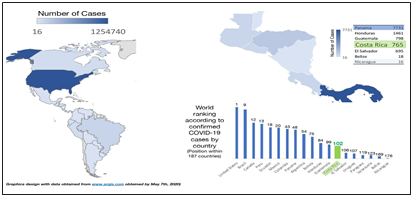
Figure 2 Epidemiologic behavior of COVID-19 in America by May 7. A. Classification of countries by number of cases confirmed. B. Analysis of the Central America region. B. World ranking according to confirmed COVID-19 cases.

Figure 3 Schematic representation of the emergency academic plan for virtualization of the curriculum of the Faculty of Dentistry, UCR.
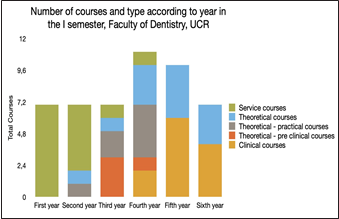
Figure 4 Distribution and classification of the courses of the 1st semester of the study plan of the Faculty of Dentistry, UCR.
Stage B-Evaluation Of The Students’ Conditions And Needs
To analyze the possibility of the students to access virtual platforms, an online survey was carried out involving all active students of the Faculty of Dentistry, using the institutional email address of each student. A 70% response rate was obtained, 450/647 students completed the questionnaire. In terms of demographics, respondents represented the seven provinces of Costa Rica (San Jose (40.9%), Alajuela (23.15%), Cartago (13.03%), Heredia (12.13%), Guanacaste (4.27%), Puntarenas (3.82%), and Limón (2.7%)). Seventy-five percent of the respondents were females and an average age of 22 years (range:17-37). According to the academic year of enrollment, 13% of respondents were first-year students, 23% second-year, 19% third-year, 14% fourth-year, 21% fifth-year, and 10% were sixth- year students. All respondents confirmed access to the internet, however, the quality and stability of the connection deferred according to the respective devices. All of the students had access to a virtual environment using either a laptop (84%), a cell phone (64%), a tablet (39%), or a desk computer (8%) (Figure 6).
Most of the students (80%) reported to have personal devices, while 20% shared them with other family members. It is important to emphasize that 4% could access the devices asynchronously, because the access priority to the device was reserved for other persons who needed to be connected for remote work or other activities. Hence, despite the accessibility to a virtual environment, the e-learning process is unequal, and university authorities must implement further improvising strategies.
Stage C-Continuing Education For The Faculty
During the adaptation process and the imminent suspension of the regular academic activities, DS authorities organized several online seminars for the faculty. Along with general continuing dental education, the seminars familiarized the faculty to the various e-learning modalities available on the university’s platforms. These seminars were not compulsory, but provided regular assistance to maintain virtual communication (Figure 7).
Specific training in topics like online evaluation, assertive ways for communication in the virtual environment, and access and management of the institutional virtual desktop were requested, and experts provided fundamental knowledge to cover these subjects. The seminars maintained a direct communication, and enhanced teamwork among the faculty members. Further research will evaluate the impact of these seminars and virtual meetings and identify any specific needs required to create new training strategies.
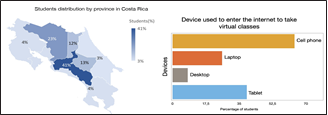
Figure 6 Demographic distribution of the students who responded to the survey, and distribution of the students according to the devices available to access the virtual platform.
Stage D-Activation Of The Virtual Platforms
After initial weeks of research and planning, the faculty could continue with the theoretical courses, using the institutional virtual platform Metics (https://metics.ucr.ac.cr ), complementing their classes with didactic activities like clinical case discussions, diagnosis and treatment plans of VPs, and interdisciplinary seminars with national and international speakers. However, as novel activities were successfully applied for some courses, others had to be suspended. As an example, a partially virtualizable course like dental anatomy included video demonstrations to familiarize the students with the activities that will be done after the COVID-19 restrictions (https://youtu.be/DBx1w5cKxJk). For the clinical courses, all the students participated in synchronous and asynchronous meetings with their instructors and classmates, to review the VP and new protocols to be implemented in the clinical activities. Additional strategies and changes will need to be analyzed for reinsertion of students and instructors to the clinical activities as the pandemic slowly starts to evolve. In this phase, feedback from the users (the students) and the guides (the teachers) is essential.
Final Considerations
A key aspect in implementing e-learning strategies in DSs is that virtualization is not a choice, but a process, and all the involved sections need to take action and make decisions to transform the established paradigms and move forward. As seen recently, many DSs began this virtualization process without the necessary preparation. The abrupt closure of the universities worldwide for the COVID-19 emergency, although undesirable, represents an enormous opportunity to some DSs to start this process and to expand the virtualization environment as a teaching/learning experience.













